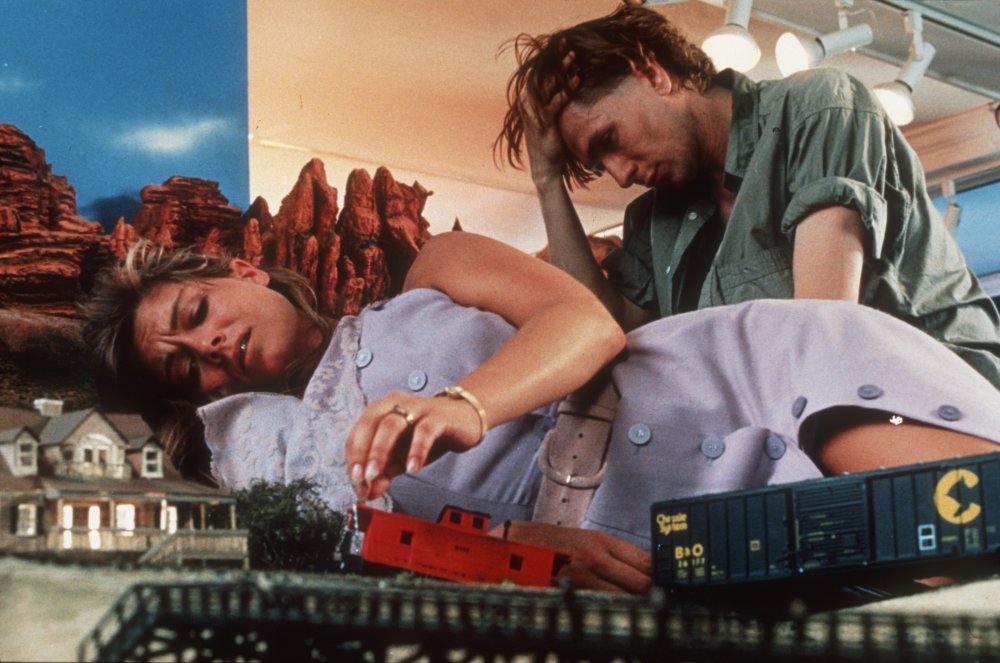
Nicolas Roeg is famous for the shot compositions in his films, filling the frame with tension and subversive sexual anxiety. In 1988, Roeg made Track 29 with George Harrison’s Handmade Films. The cast included Theresa Russell, Gary Oldman, Christopher Lloyd, Sandra Bernhard and Seymour Cassel. Track 29 shares similar themes with Roeg’s other significant 80s films such as Eureka (1983) and Bad Timing (1980). Themes that revolve around the nature of human sexuality (such as incest, fetishism, and rape), focusing on the psychological and sociological ramifications these tendencies have for the characters in his films.
Theresa Russell and Christopher Lloyd play husband and wife Dr. Henry Henry and Linda Henry. Each is dissatisfied with what the other brings to the relationship. Henry has an obsession for model trains, an obsession Linda cannot help but mock. Several rooms of their house are dedicated to Henry’s model train set-up. Linda longs for a child, something Henry refuses at every instant. In turn, Linda surrounds herself with baby dolls. Linda also has a sexual fetish made clear in a scene where she attempts to entice Henry to make love to her. She likes Henry to be “daddy” and herself to be “baby”. That fetish for incestual relations will manifest itself again in the film. Both characters find solace in the accoutrements of what would typically be considered childhood. The manifestation of these surroundings make evident that which has yet to be fulfilled by either character, forcing them to resort very often to behavior signified by their possessions.
At the clinic where he works, Henry Henry is carrying on a love affair with Nurse Stein (Bernhard). This relationship is based on a mutual sexual fetish involving toy trains and spanking. In the film, it is the noise of this “therapy”, as Henry puts it, which prompts them both to be dismissed. From there, they attend a Trainorama where Henry is the key speaker.
Meanwhile, Linda is living the stereotypical life of the American Housewife. That is, until she encounters Martin (Gary Oldman) at a diner. Their brief exchange leads to very little. However, the character of Martin re-occurs as Linda’s psychological projection. Throughout the film there are flashbacks to when Linda was 15 at a carnival. While riding the bumper cars she meets and is later raped and impregnated by a rough and tumble youth (Gary Oldman). We learn from other flashbacks and her exchanges with Martin that her baby was put up for adoption. It is this child that Martin claims to be, though he only claims this when appearing as Linda’s mental projection.
Martin first appears as a figment of Linda’s subconscious after she has tried to drown herself. He stands by her pool, watching her kick as she tries to stay submerged. In the following scenes, as they go about their day, Martin will shift his behavior from that of innocent child to sinister seducer. He represents the two things Linda desires most, the child she lost and the rough seducer of the carnival. His shifts between roles are dictated by her mood and wants.
Martin also realizes other desires Linda has. He will demolish Henry’s train sets and murder Henry. By allowing Martin to do these things, though she has really done them, Linda can disassociate herself from her actions. What is truly intriguing about Roeg’s execution of this is how he allows the ambient sounds of Linda’s television to provide a running commentary, often with comic effects. These commentaries come from such eclectic places as The Twilight Zone, Wonder Dog, and J. Lee Thompson’s film Cape Fear. This juxtaposition illuminates the point and counterpoint realities Linda manufactures and actually exists in within the confines of the narrative.
One of the film’s more striking sequences is a montage cutting back and forth between Henry’s rousing speech at Trainorama and Martin demolishing the train sets. The pacing heightens the psychological anarchy of Linda and personifies through contrast the frenzy of Henry’s speech. This montage reaches its climax when a truck plows through Linda’s bedroom.
The truck appears early in the film when Martin, not appearing as any projection of Linda’s, hitch-hikes into town. This is one of the most comical moments in Track 29. The trucker who picks him up has a number of tattoos spelling “mother”. Martin, searching for his mother, runs his mouth on the subject till the trucker gives him the boot. However, the tattoos and wardrobe of the trucker are those worn by Linda’s carnival seducer. o by bringing the truck into the above-mentioned montage, Roeg is solidifying the cyclical relationship of rapist and child, which Martin has come to represent in the mind of Linda. From the rape came a child, and from a child comes rape again. The circular nature of Linda’s desires creates a psychological spiral whose end is a complete breakdown, manifesting itself with the death of Henry.
Track 29 is Roeg’s most complicated work in psychological portraiture of a single character since his debut Performance (1970). Sexuality and psychological violence are always intertwined in Roeg’s films, often reaching a climax in which a character destroys themselves or allows themselves to be destroyed because of this connection and its manifestation in the character’s behavior. Such is the case in Eureka, Performance, Bad Timing, The Man Who Fell To Earth and Castaway(1987). It’s an obsession of the director, and it has served him well. Of Roeg’s films, this is one of the more difficult, but if you are versed in the cinema of Roeg, it is a definite must see.
